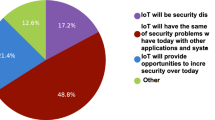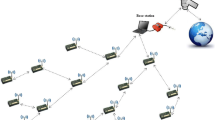Abstract
Intrusion detection is a very sensitive and major concern in wireless sensor networks. In border areas, sensors are installed to discover the presence of enemies or any trace passing in a prohibited area or any vicious moving object in the region of interest. In order to gain access to a region of interest, an intruder can take various paths, i.e., it can move along a straight line, follow a zigzag path or a curved path and move at a particular angle to cross the region without being detected and to improve its attacking ability. This paper formulates and analyzes \(\kappa\)-barrier coverage probability which acts as the intrusion detection probability for an intruder when the intruder follows different paths at different path angles with respect to the shortest path to cross the region of interest in a mobile sensor network. Furthermore, the effect of different network variables such as node density, sensing range, intrusion path angle and the ratio of sensor to intruder velocity on intrusion detection probability are also investigated. It is believed that the proposed model renders an effective tool to incorporate the intruder’s movement pattern in the design of an advanced finite wireless sensor network.














Similar content being viewed by others
References
Nagar, J., Chaturvedi, S. K., & Soh, S. (2020). An analytical model to estimate the performance metrics of a finite multihop network deployed in a rectangular region. Journal of Network and Computer Applications, 149, 102466.
Wang, Y., Wang, X., Xie, B., Wang, D., & Agrawal, D. P. (2008). Intrusion detection in homogeneous and heterogeneous wireless sensor networks. IEEE Transactions on Mobile Computing, 7(6), 698–711.
Assad, N., Elbhiri, B., EL Fkihi, S., Faqihi, M. A., Ouadou, M., & Aboutajdine, D. (2014). Short: Intrusion detection quality analysis for homogeneous wireless sensor networks. In Networked systems, 8593, (pp. 324–329).
Butun, I., Morgera, S. D., & Sankar, R. (2014). A survey of intrusion detection systems in wireless sensor networks. IEEE Communications Surveys & Tutorials, 16(1), 266–282.
Nagar, J., & Sharma, S. (2018). k-barrier coverage-based intrusion detection for wireless sensor networks. In M. Bokhari, N. Agrawal, & D. Saini (Eds.), Cyber security (Vol. 729)., Advances in intelligent systems and computing Singapore: Springer.
Abdellatif, T., & Mosbah, M. (2018). Efficient monitoring for intrusion detection in wireless sensor networks. Concurrency and Computation: Practice and Experience, 32, 1–13.
Verma, A., & Ranga, V. (2020). Machine learning based intrusion detection systems for IoT applications. Wireless Personal Communications, 111, 2287–2310.
Zhang, R., & Xiao, X. (2019). Intrusion Detection in wireless sensor networks with an improved NSA based on space division. Journal of Sensors, 2019, 1–20.
Wang, Y., Weihuang, F., & Agrawal, D. P. (2013). Gaussian versus uniform distribution for intrusion detection in wireless sensor networks. IEEE Transactions on Parallel and Distributed Systems, 24(2), 342–355.
Ghosh, K., Neogy, S., Das, P. K., & Mehta, M. (2018). Intrusion detection at international borders and large military barracks with multi-sink wireless sensor networks: An energy efficient solution. Wireless Personal Communication, 98, 1083–1101.
Arjun, D., Indukala, P. K., & Unikrishna Menon K. A. (2017). border surveillance and intruder detection using wireless sensor networks: A brief survey. In International conference on communication and signal processing, April 6-8, 2017, India.
Phipatanasuphorn, V., & Ramanathan, P. (2004). Vulnerability of sensor networks to unauthorized traversal and monitoring. IEEE Transactions on Computers, 53(3), 364–369.
Liu, B., Dousse, O., Nain, P., & Towsley, D. (2013). Dynamic coverage of mobile sensor networks. IEEE Transactions on Parallel and Distributed Systems, 24(2), 301–311.
Liu, B., Brass, P., Dousse, O., Nain, P., & Towsley, D. (2005). Mobility improves coverage of sensor networks. In Proceedings of the 6th ACM international symposium on mobile Ad Hoc networking and computing (Mobihoc), (pp. 300–308).
Keung, G. Y., Li, B., & Zhang, Q. (2012). The intrusion detection in mobile sensor network. IEEE/ACM Transactions on Networking, 20(4), 1152–1161.
Sagar, A. K., & Lobiyal, D. K. (2015). Probabilistic intrusion detection in randomly deployed wireless sensor networks. Wireless Personal Communications, 84(2), 1017–1037.
Wang, Y. (2009). Intrusion detection in Gaussian distributed heterogeneous wireless sensor networks. In IEEE GLOBECOM, (pp. 1–6).
Keramatpour, A., Nikanjam, A., & Ghaffarian, H. (2017). Deployment of wireless intrusion detection systems to provide the most possible coverage in wireless sensor networks without infrastructures. Wireless Personal Communication, 96, 3965–3978.
Olteanu, A., Xiao, Y., Wu, K., & Xiaojiang, (2010). Weaving a proper net to catch large objects in wireless sensor networks. IEEE Transactions on Wireless Communication, 9(4), 1360–1369.
Mostafaei, H., & Meybodi, M. R. (2014). An energy efficient barrier coverage algorithm for wireless sensor networks. Wireless Personal Communication, 77(3), 2099–2115.
Wang, Y., Chu, W., Fields, S., Heinemann, C., & Reiter, Z. (2016). Detection of intelligent intruders in wireless sensor networks. Future Internet, 8(2), 1–18.
Wang, Y, Leow, Y. K., & Yin, J. (2009). Is straight-line path always the best for intrusion detection in wireless sensor networks?. In IEEE 15th ICPDS, (pp. 564–571).
Hossain, A., Biswas, P. K., Chakrabarti, S. (2008). Sensing models and its impact on network coverage in wireless sensor network. In 3rd International Conference on Industrial and Information Systems (ICIIS), (pp. 1–5).
Amutha, J., Sharma, S., & Nagar, J. (2020). WSN Strategies based on sensors, deployment, sensing models, coverage and energy efficiency: Review, approaches and open issues. Wireless Personal Communications, 111, 1089–1115.
Camp, T., Boleng, J., & Davies, V. (2002). A survey of mobility models for ad hoc network research. Wireless Communications & Mobile Computing, 2(5), 483–502.
Kabilan, K., Bhalaji, N., Selvaraj, C., Kumaar, M. B., & Karthikeyan, P. T. R. (2018). Performance analysis of IoT protocol under different mobility models. Computers & Electrical Engineering, 72, 154–168.
Author information
Authors and Affiliations
Corresponding author
Additional information
Publisher's Note
Springer Nature remains neutral with regard to jurisdictional claims in published maps and institutional affiliations.
Rights and permissions
About this article
Cite this article
Sharma, S., Nagar, J. Intrusion Detection in Mobile Sensor Networks: A Case Study for Different Intrusion Paths. Wireless Pers Commun 115, 2569–2589 (2020). https://doi.org/10.1007/s11277-020-07697-1
Published:
Issue Date:
DOI: https://doi.org/10.1007/s11277-020-07697-1




